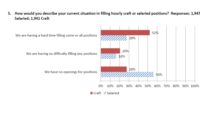A large majority of construction contractors report continued problems in filling open positions for craft workers, according to a new survey.
Officials at the Associated General Contractors of America—which produced the survey with Autodesk—called on the federal government to takes steps to assist industry efforts to bolster the number of craft workers entering the workforce.
In releasing the report on Aug. 27, AGC Chief Executive Officer Stephen E. Sandherr said, “Workforce shortages remain one of the single most significant threats to the construction industry.”
Sandherr added, “However, construction labor shortages are a challenge that can be fixed, and this association will continue to do everything in its power to make sure that happens.”
About 80% of the survey's nearly 2,200 respondents said that they still face difficulties in locating enough candidates for hourly craft worker jobs.
The responses varied little from region to region, with 83% of contractors in the West and South, 81% in the Midwest and 75% in the Northeast reporting hiring problems. The survey also included results for 23 individual states.
The survey found that the workforce shortages hit large, medium and small companies to nearly the same degree.
"If left unaddressed, workforce shortages could cause contractors to turn down work and, eventually, dampen economic growth," said Ken Simonson, AGC's chief economist, who oversaw the survey.
Another key finding of the annual study is that a majority of the contractors surveyed are skeptical of the quality of the pipeline for recruiting and preparing new craft personnel. About 45% of respondents rate the pipeline as poor.
In addition, 26% say the pipeline for hiring craft workers who can pass a drug test is poor; 47% rate that pipeline as fair. Only 27% said it was good or excellent.
Simonson noted that the 73% of respondents who rated new craft workers' ability to pass a drug test as poor or fair represents a small increase over last year's 70%.
Responses to the "pipeline" questions did differ between the 288 companies that said they always operate as a union contractor and the 859 firms who said they always operate as an open-shop contractor.
About 30% of union contractors rated the local pipelines for supplying well-trained, skilled craft personnel as poor and 41% said they were "fair." About 54% of open-shop firms graded those pipelines as poor; 38% rated them "fair."
On the upper end of the ratings, 5% of union contractors rated the pipeline for supplying well-trained, skilled personnel as excellent and 24% said it was good. But none of the open-shop firms said the pipeline was excellent and only 8% rated it as good.
Among other findings, 44% of the contractors said they are increasing construction prices and 29% are factoring longer completion times into their bids for new work, because of the lack of qualified workers.
Seeking government help
To try to stem the ongoing shortage, Sandherr called on the federal government to boost funding for career and technical education.
He also asked Congress and the White House to allow more immigrants to enter the country to work in construction, and permit construction students at community and career colleges to qualify for federal Pell Grants.
Sandherr wants state and federal officials to make it easier for construction firms to establish apprenticeship and other training programs.
Half of the respondents reported getting involved with career-building programs at high school and college levels. In addition, 46% of firms said that they have launched or expanded in-house training programs because of worker shortages.
About 29% of the companies surveyed said that they are investing in new technology to automate processes and workflows. One-fourth of the firms said they are making increased use of advanced technologies, such drones, robots and 3-D printers.






Post a comment to this article
Report Abusive Comment